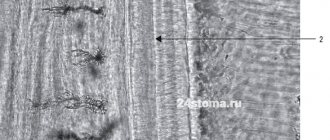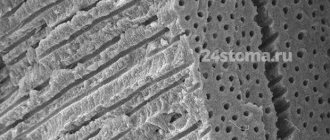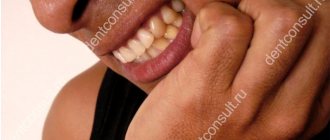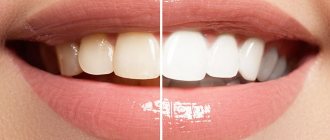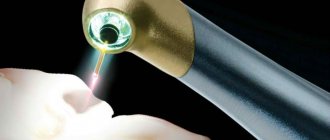Published 06/11/2020
The information in this article is provided for educational purposes and cannot be used for self-diagnosis, self-treatment and does not replace consultation with a doctor.
Dental cement is used to fill or make dental prosthetics. There are several types of it, most often used in dental practice, however, the type of fixation is divided into permanent and temporary.
How are cementum, tooth sensitivity and periodontitis related?
Loss of cementum contributes to a number of dental problems, such as tooth sensitivity, loss of enamel, and gum recession . When cementum is lost, the dentin underneath is exposed, and this, in turn, can cause tooth sensitivity. The latter manifests itself as short-term or acute pain in the area of one or more teeth. If you've ever winced and winced painfully after taking a sip of cold water or juice, you know the feeling!
While cementum loss can trigger the development of some dental diseases, other dental diseases can trigger cementum loss. Such diseases include, for example, periodontitis. Cementum loss occurs when there is irreversible damage to the bone and connective tissue fibers that hold the tooth in place. Such damage to bone tissue and cement is characteristic of progressive periodontitis and leads to tooth mobility, which in some cases even has to be removed.
Permanent or temporary cement?
In root canal treatment, temporary cement also has its place - even when a permanent crown is ready, the therapist may need access to the root canals, which means it is better to install a permanent crown with temporary cement. Otherwise, if root canal access is needed and the permanent crown has been placed with permanent cement, the therapist will need to make a hole in the crown to access the canals. In this case, there is a risk of cracks forming, which could cause crown breakage in the future.
A logical question arises: “Why not fix all crowns with temporary cement?” The answer is simple: an experienced dentist, after carrying out the necessary treatment, can confidently place a permanent crown on permanent cement, because he knows that the root canals have been treated efficiently and will not require opening the crown. If tooth extraction was recommended, but the patient insisted on canal treatment and there is no guarantee for such treatment, then a crown with temporary cement is installed.
Moreover, permanent cement ensures that the crown is tightly fixed to the tooth so that saliva and bacteria do not get under the crown.
Another point is the peace of mind and confidence of the patient: with permanent cement, he will not need to come to the dental clinic every few months, except for a general preventive examination.
What other problems are associated with dental cement?
In addition to the loss of cementum, which can be the result of periodontitis and at the same time cause tooth sensitivity, there are several other dental problems directly related to the condition of this tissue.
Cementoblastoma
This long word refers to a rare benign tumor on the root of a tooth. It occurs when specific cells, cementoblasts, grow in the area of the root apex. Typically, cementoblastoma affects one tooth root, but sometimes it can develop on several roots and spread to the surrounding bone. The growth of cementoblastoma is sometimes accompanied by dull pain, but often the disease is asymptomatic. Being a benign tumor, cementoblastoma, however, is constantly increasing in size; Over time, it can begin to interfere with the normal functioning of the teeth and affect the patient's appearance.
Adolescents and young adults under 30 years of age are at higher risk of developing cementoblastomas. Treatment of cementoblastoma involves surgical removal of the tumor and the affected tooth, which most often turns out to be a premolar or molar of the lower jaw. Sometimes several teeth have to be removed. Although tooth extraction is by no means the optimal solution, the risk of tumor regrowth makes it necessary. Although cementoblastoma is a rare condition, it is best to make sure that pain or strange thickening in the area of the tooth roots is not associated with it. To do this, you should contact your dentist.
Exposure of the cemento-enamel junction (CEJ)
The cemento-enamel junction is a special zone around the perimeter of the tooth where the enamel covering the crown meets the cement protecting the root. In most cases, the cement partially extends onto the enamel, covering it, but in some people there is a thin strip of unprotected dentin between the hard enamel and the less mineralized cement.
sensitivity to cold and hot foods may occur The exposure of the CEJ is associated with recession, that is, drooping of the gums.
To confirm that the sensitivity is caused by gum recession, the dentist will need to measure how much the gums have receded. To do this, use a special tool, a periodontal probe, which the dentist inserts between the gum and tooth. This examination will determine whether the periodontal ligament is in good condition or whether there is a risk of infection, inflammation and further gum recession.
Hypercementosis
Hypercementosis is the process of formation of an excessively thick cement layer on the roots of teeth. Local thickening of the cement leads to a change in the size and shape of the root, which in some cases even begins to interfere with neighboring teeth.
Although the exact causes of hypercementosis are unknown, dentists typically diagnose it in patients with certain medical conditions, such as arthritis, rheumatoid arthritis, acromegaly, and Paget's disease. Researchers have also associated hypercementosis with vitamin A deficiency. Hypercementosis also occurs in patients with periodontal disease or dental trauma caused by occlusal disorders. For the most part, hypercementosis occurs in adults, and the risk of developing it increases with age.
That's how many new words you learned today! Of course, this amount of information is difficult to digest at once, but understanding the important role of cement will help you take a more responsible approach to protecting your teeth. Start with proper oral care to avoid lost or damaged cementum. By regularly brushing your teeth and using dental floss, an interdental brush or irrigator, and an antiseptic mouthwash, you can maintain the health of your teeth and all their tissues.
Dental cement
Today in dentistry, “cement” is used not only for fillings, but also for prosthetics. This is a homogeneous and flexible mass that is obtained from powder and liquid. The latter hardens as a result of a chemical reaction.
Most often, dental cement is used for:
- Filling crowns;
- Filling dental crowns;
- Creation and fixation of fillings on the crown;
- When using fixed prosthetics.
Cement is used in most cases in pediatric dentistry. This is explained by the specific structure of baby teeth. Another direction where the mixture is used is the installation of fillings in adults. But since it begins to crumble fairly quickly, it is not used for permanent filling.
On this page you can find out detailed information about the methods and features of dental fillings in our clinic.
And here you can learn in detail about the indications for use and methods of installing a dental pin.
Such a material must have the following properties:
- biocompatibility , that is, it should not be rejected by living tissues;
- correct curing time , if the material hardens too early, it may not harden correctly and the procedure will have to be redone, the same can happen if hardening takes too long;
- hypoallergenic , the material should not cause an allergic reaction;
- strength , it will allow the material not to fall apart under chewing load on the tooth;
- aesthetics , especially important when using cement on the front teeth;
- homogeneous structure allows it to be evenly distributed throughout the dental canals;
- resistance to staining , such material should not be stained when eaten.
The fixation of metal-ceramic crowns can be divided into two groups: permanent and temporary. Ceramics are fixed with cement when the crown is installed for a short period of time and after a while it will need to be removed for subsequent treatment. As for long-term fastening, adhesives are used in this case.
Dental cement is distinguished by its flexibility at the setting stage and durability after hardening. There is a large range of mixtures of different shades for orthopedics and pediatric dentistry.
Based on the composition of the mixture, they are divided into
- phosphate (zinc and phosphoric acid);
- silicate (aluminum, phosphoric acid);
- glass ionomer (glass, polyacrylic acid).
Unitem white (50g+30ml), VladMiVa
Cement for fixing pins, crowns, bridges and inlays. Unitem has high mechanical strength and chemical resistance.
- Description
- Shipping and payment
- Reviews
Description
Unicem is a universal zinc phosphate cement formed by mixing zinc oxide powder and phosphoric acid solution.
Indications
- Fixation of crowns, bridges, pins, inlays.
- Filling teeth that are to be covered with a crown.
- Can be used as an insulating gasket when filling with silicate and silica-phosphate cements, as well as amalgams.
Characteristics
- Powder: 50 g.
- Bottle of liquid: 30 ml.
- Powder measuring cup: 1 pc.
- Dropper cap: 1 pc.
Compound
- Zinc oxide powder with modifying additives.
- Orthophosphoric acid of reduced activity.
Cement mixing process
Advantages
- High mechanical strength (90-120 MPa, depending on the ratio of powder and liquid).
- High adhesion to metal, plastic, porcelain, metal ceramics and other dental materials.
- Cement is resistant to the aggressive action of the moist environment of the oral cavity.
Instructions for use
- If the material has been stored or transported at low temperatures, it should be kept at room temperature for one hour before use.
- On a dry glass plate, gradually mix the powder and liquid in the required proportion.
- The mixing time should not exceed 1 minute.
- Apply cement to the previously treated and dried tooth surface.
- The hardening time of the cement is 2 hours; during this period it is recommended to cover the filling with varnish or hydrophobic gel to protect it from the action of saliva.
Fixation of prostheses
- 1 scoop of powder (0.25-0.30 g) + 4 drops of liquid (0.18-0.20 g).
- The dough remains plastic on glass for 2-2.5 minutes, and hardens in the oral cavity within 8 minutes.
Dental filling
- 1 scoop of powder (0.25-0.30 g) + 3 drops of liquid (0.13-0.15 g).
- The dough remains plastic on glass for 1-1.5 minutes, and hardens in the oral cavity within 6 minutes.
Storage
- Store in a dry place, protected from direct sunlight, in a tightly closed container.
- Storage temperature: from +5°C to +25°C.
- Avoid exposure to moisture.
- Shelf life: 5 years.
The Nika Dent company is the official distributor of VladMiV products. We supply dental materials and consumables throughout Russia.
Shipping and payment
PAYMENT METHODS
| Cash to the courier upon receipt of the goods. Possible: in Moscow, Moscow region, St. Petersburg, Leningrad region. |
| By bank transfer for legal entities by account. |
TRANSFERING THE ORDER TO THE DELIVERY SERVICE
For cash payments:
the next day after receiving the order, unless a different delivery date has been agreed upon.
For non-cash payments:
the next day after receiving the money to the bank account.
Please check with your manager about the possibility of same-day delivery.
DELIVERY METHODS
Delivery by our transport is carried out in Moscow, Moscow region, St. Petersburg and Leningrad region.
To all other regions, delivery is carried out by transport companies.
Pickup of goods from the warehouse and company office is not provided.
COST OF DELIVERY
| Within the Moscow Ring Road: when ordering over 3,000 rubles - free. Up to 3,000 rubles – we temporarily do not deliver. |
| IN ST. PETERSBURG : when ordering over 3,000 rubles - free. Up to 3,000 rubles – delivery cost 350 rubles. |
| IN THE MOSCOW REGION: up to 50 km from the Moscow Ring Road: for orders over 5,000 rubles - free. Up to 5000 rubles – we temporarily do not deliver. 50-100 km from the Moscow Ring Road: for orders over 30,000 rubles - free. Up to 30,000 rubles – we temporarily do not deliver. |
| IN THE LENINGRAD REGION: up to 20 km from the Ring Road: for orders over 5,000 rubles - free. In all other cases - individually |
| TO OTHER REGIONS The minimum order amount to the regions is 3,000 rubles. Delivery is carried out by a transport company. The cost of delivery to the Moscow base of the transport company is free. Payment for the services of the transport company is at the expense of the client. We work with any Transport companies convenient for you! |
Repeated delivery due to the buyer's fault will be paid in any case!
Reviews
There are no reviews for this product yet. Be the first to leave a review!
Structure, types of cement
Cementum is represented by cells and intercellular substance. The cells are cementocytes, cementoclasts and cementoblasts.
Histologically, there are 2 types of cement: acellular and cellular.
Acellular cement, or primary cement as it is called, does not contain cells - only calcified intercellular substance. Its thickness is 23-40 microns. Covers the neck of the tooth.
Secondary cement (or cellular) covers the root with a small layer, located below the neck of the tooth. Cementocytes, process cells, are found in large numbers in the interroot sections and in the area of the apical part of the root. Cemetoblasts are also isolated, which are located on the surface of the cement. Cementocytes are localized in the thickness of the cementum of the tooth. Secondary cement is localized on acellular or dentin.
Compared to the primary, the secondary is formed much faster. Cementocytes are characterized by many branching processes and the presence of a large nucleus. When they die, they leave gaps in deeper layers. Closer to the periphery, cementoblasts are similar to cementoblasts and are more “active”. The latter contribute to the deposition of cement.
The intercellular substance is represented by collagen fibers, which, depending on their location, are divided into several types:
- growing into dentin;
- extending into the periodontium;
- localized within the cement, internal;
- growing into the periosteum of the alveoli.
The intercellular substance is also represented by mineralized glycosaminoglycans and matrix. Intercellular fibers are formed by their own cells (that is, cementum cells) and run parallel to the root. The fibers of the periodontal ligament, which are also part of the alveolar bone, pass at right angles to the tooth.
Securing crowns with cement: technology features, pros and cons
The traditional method used by dentists at the start of prosthetics with implants and which has not lost its relevance to this day is as follows.
After comprehensive preparation of the oral cavity in general and the area for dental implantation in particular, the patient is implanted with an implant simulating the root of a tooth, onto which an add-on is installed - an abutment. And already on the abutment, using the same technology as on your own tooth, a crown is installed, fixed with cement.
Among the advantages of this method, it should be noted, first of all, affordability, ease of implementation and preservation of the integrity of the crown. The disadvantages of fixing a crown to an implant using dental cement are:
- entry of excess solution formed during fixation due to extrusion into the space between the gum and abutment. It is impossible to notice this process from the outside, so neither the patient nor the dentist can be sure that the cement has not entered the gum. In this case, there is a risk of inflammation of the bone tissue adjacent to the implant - peri-implantitis. Treatment of such a disease is long, complex and not always successful. A negative prognosis is the loss of the implant and part of the bone tissue, after which it will require its augmentation, and then re-implantation;
- If at least minimal inaccuracies were made when taking an impression and making the crown, its fit to the abutment will not be tight, which means that the dental cement filling this gap will be washed away by saliva over time. Its place will be taken by soft plaque containing pathogenic bacteria. As a result of decementation, the crown will simply fall out, and due to the action of bacteria, the previously mentioned peri-implantitis may begin to develop, followed by loss of the implant and bone mass.
